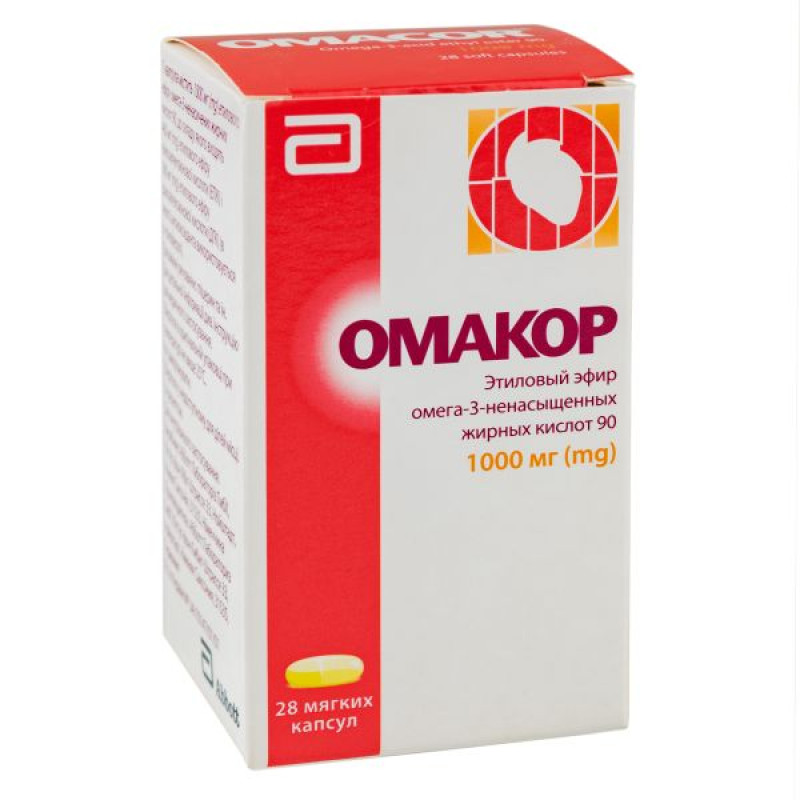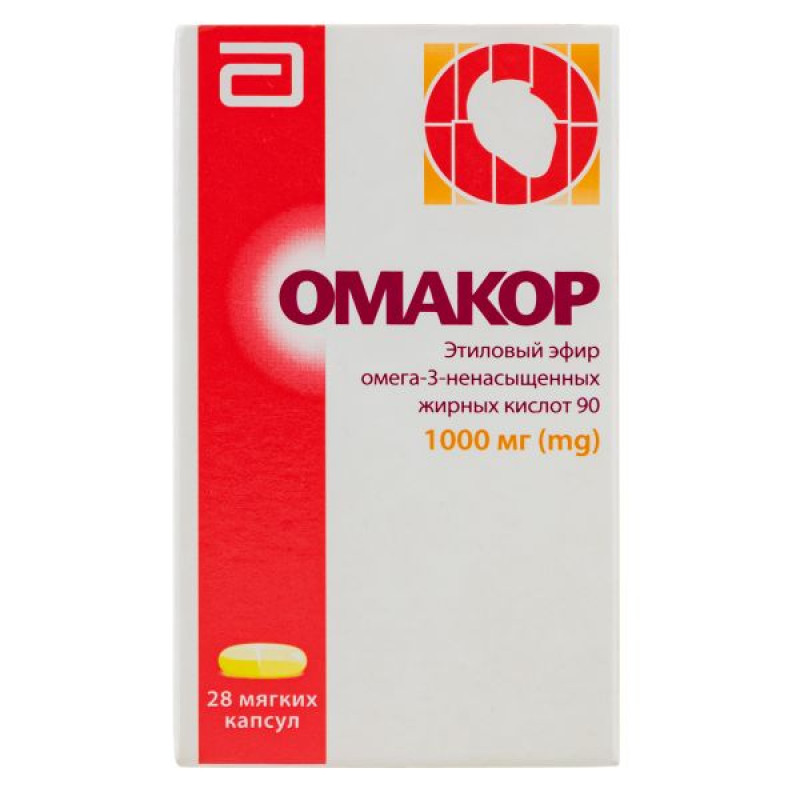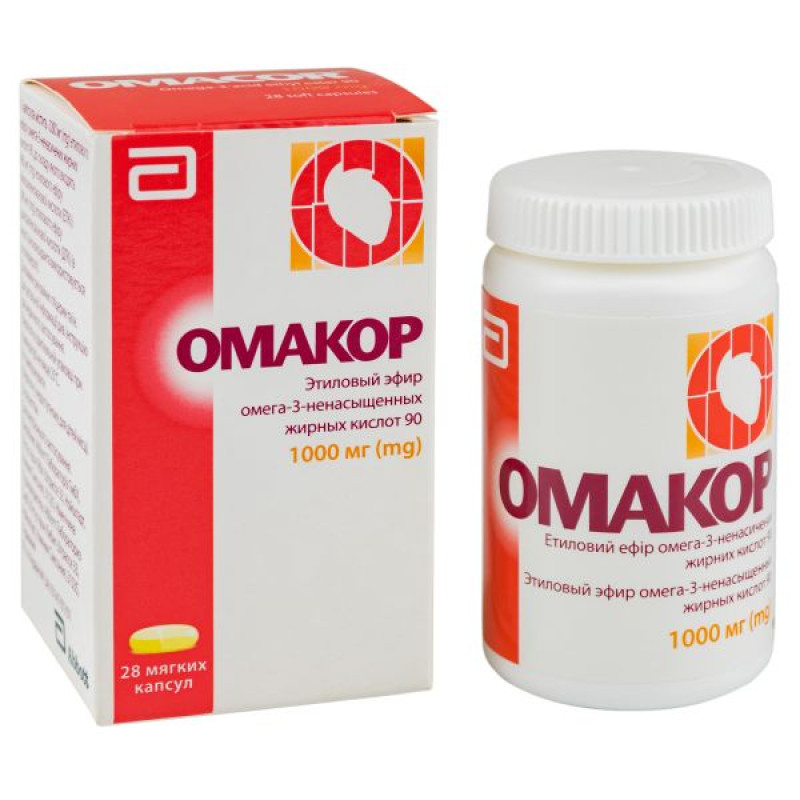Omakor soft capsules 1000 mg No. 28

Instructions for Omakor soft capsules 1000 mg No. 28
Composition
active ingredient: ethyl ester of omega-3-unsaturated fatty acids 90;
1 capsule contains 1000 mg of ethyl ester of omega-3-unsaturated fatty acids 90, which includes 460 mg of ethyl ester of eicosapentaenoic acid (EPA) and 380 mg of ethyl ester of docosahexaenoic acid (DHA) (α-tocopherol is used as an antioxidant);
Excipients: capsule shell: gelatin, glycerin, medium chain triglycerides, lecithin, purified water.
Dosage form
Soft capsules.
Main physicochemical properties: oblong transparent soft capsule size 20, filled with pale yellowish oil.
Pharmacotherapeutic group
Hypolipidemic agents. Omega-3-ethyl esters of acids.
ATX code C10A X06.
Pharmacological properties
Pharmacodynamics
Omega-3 polyunsaturated fatty acids – eicosapentaenoic acid (EPA) and docosahexaenoic acid (DHA) – are essential fatty acids.
Omacor affects blood plasma lipids, reducing triglyceride levels, which leads to a decrease in very low density lipoprotein (VLDL) levels. In addition, Omacor affects hemostasis and blood pressure.
Omacor reduces triglyceride synthesis in the liver because EPA and DHA are weak substrates for enzymes responsible for triglyceride synthesis and inhibit the esterification of other fatty acids.
Increased β-oxidation of fatty acids in liver peroxisomes also contributes to triglyceride reduction by reducing the amount of free fatty acids available for triglyceride synthesis. Reduced triglyceride synthesis leads to reduced very low density lipoprotein (VLDL) levels.
In some patients with hypertriglyceridemia, Omacor increases low-density lipoprotein (LDL) cholesterol. The increase in high-density lipoprotein (HDL) cholesterol with Omacor treatment is small, significantly less than that observed after the use of fibrates, and is not constant.
The long-term effects of lipid lowering (beyond 1 year) are unknown. That is, there is no convincing evidence that lowering triglycerides reduces the risk of coronary heart disease.
During treatment with Omacor, there is a decrease in the formation of thromboxane A2 and a slight increase in bleeding time. No significant effect on other blood clotting factors is observed.
In the multicenter randomized open clinical trial GISSI-Prevenzione, 11,324 patients after myocardial infarction (< 3 months) who received standard preventive treatment and a Mediterranean diet were randomized to the following groups: Omacor (n=2836), Vit. E (n=2830), Omacor + Vit. E (n=2830) or without Omacor and Vit. E (n= 2828).
Results obtained over 3.5 years showed that taking Omacor at a dose of 1 g/day significantly reduced the incidence of a combined endpoint, which included all-cause mortality, non-fatal myocardial infarction, and non-fatal stroke (relative risk reduction of 15% [2-26] p=0.0226 in patients taking Omacor alone compared to control, and 10% [1-18] p=0.0482 in patients taking Omacor with or without vit. E). A reduction in the secondary endpoint of cardiovascular death, non-fatal myocardial infarction, and non-fatal stroke was also demonstrated (relative risk reduction of 20% [5-32] p=0.0082 in patients taking Omacor alone compared with control, and 11% [1-20] p=0.0526 in patients taking Omacor with or without vitamin E). Secondary analysis of each component of the primary endpoints showed a significant reduction in the incidence of all-cause and cardiovascular deaths separately, but without a reduction in non-fatal cardiovascular events or fatal and non-fatal stroke.
Pharmacokinetics
During and after absorption, there are three main pathways for the metabolism of omega-3 fatty acids:
- fatty acids are first transported to the liver, where they are incorporated into various categories of lipoproteins, and then transferred to peripheral lipid depots;
‒ phospholipids of cell membranes are replaced by phospholipids of lipoproteins, and fatty acids can then act as precursors of various eicosanoids;
- most fatty acids are oxidized to meet energy needs.
The concentration of omega-3 fatty acids – EPA and DHA – in plasma phospholipids corresponds to the concentration of EPA and DHA incorporated into cell membranes.
Pharmacokinetic studies in animals have demonstrated complete hydrolysis of the ethyl esters, accompanied by sufficient absorption and incorporation of EPA and DHA into plasma phospholipids and cholesterol esters.
Indication
After myocardial infarction
Adjunctive therapy for secondary prevention after myocardial infarction as an adjunct to other standard treatments (e.g. statins, antiplatelet agents, β-blockers, angiotensin-converting enzyme inhibitors).
Hypertriglyceridemia
In endogenous hypertriglyceridemia, Omacor should be used as an adjunct to diet therapy if dietary measures are insufficient to achieve an adequate response:
· type IV as monotherapy;
· types IIb/III in combination with statins, if blood triglyceride levels are not adequately controlled.
Contraindication
Hypersensitivity to the active substance, to soy or to any other components of the drug.
Interaction with other medicinal products and other types of interactions
Oral anticoagulants or other medicinal products that affect coagulation (e.g. acetylsalicylic acid or NSAIDs) (see section "Special warnings and precautions for use").
The use of Omacor together with warfarin did not lead to any hemorrhagic complications. However, in the case of combined use of Omacor and drugs that affect prothrombin time/international normalized ratio (PT/INR), or in the event of discontinuation of Omacor treatment, monitoring of PT/INR is necessary.
Application features
Due to a moderate increase in bleeding time (when using high doses, i.e. 4 capsules per day), monitoring of the condition of patients with blood clotting disorders or patients receiving anticoagulant therapy or other drugs that may affect coagulation (e.g. acetylsalicylic acid or NSAIDs) is necessary, and appropriate adjustment of the anticoagulant dose if necessary (see section "Interaction with other medicinal products and other types of interactions").
The use of this drug does not eliminate the need for supervision usually required for such patients.
Prolonged bleeding time should be considered in patients at high risk of bleeding (due to severe trauma, surgery, etc.).
During treatment with the drug, the formation of thromboxane A2 is reduced. No effect on other blood clotting factors was observed. Some studies using omega-3 polyunsaturated fatty acids have shown a prolongation of bleeding time, but this bleeding time value did not exceed the normal range and did not lead to clinically significant bleeding events.
Small but significant increases (within the normal range) in AST and ALT have been reported in some patients, but there is no evidence to suggest an increased risk in patients with hepatic impairment. In patients with any evidence of hepatic impairment (especially at high doses, i.e. 4 capsules per day), ALT and AST levels should be monitored.
Omacor is not indicated for the treatment of exogenous hypertriglyceridemia (type 1 hyperchylomicronemia). Experience in secondary endogenous hypertriglyceridemia (especially in decompensated diabetes) is limited. There are no data on the use of the drug in combination with fibrates in the treatment of hypertriglyceridemia.
Use during pregnancy or breastfeeding
Pregnancy.
There is no experience with the use of Omacor during pregnancy. The potential risk to humans is unknown, therefore Omacor should not be prescribed during pregnancy unless clearly necessary.
Breast-feeding.
There are no data on the excretion of Omacor in human breast milk. The drug should not be used during breastfeeding.
Ability to influence reaction speed when driving vehicles or other mechanisms
The effect of the drug on the ability to drive or use machines has not been studied. However, Omacor is expected to have no or negligible influence on the ability to drive or use machines. Drivers should be aware of the possibility of dizziness.
Method of administration and doses
After myocardial infarction
1 capsule per day.
Hypertriglyceridemia
The initial dose is 2 capsules per day (in 1 or 2 doses). In case of insufficient effect, the dose can be increased to 4 capsules per day. The duration of the course of treatment is determined by the doctor depending on the individual characteristics of the body.
Capsules can be taken with food to prevent gastrointestinal upset.
There is no information on the use of Omacor in children and adolescents, patients over 70 years of age, and patients with hepatic insufficiency (see section "Special warnings and precautions for use"), and there is limited information on the use in patients with renal insufficiency.
Children
Due to the lack of data on the effectiveness and safety of Omacor in children, its use is not recommended for this category of patients.
Overdose
Due to the lack of data, no specific recommendations can be made. Treatment should be symptomatic.
Adverse reactions
The frequency of adverse reactions, according to research data, is arranged as follows: very common (≥ 1/10); common (≥ 1/100 to < 1/10); uncommon (≥ 1/1000 to < 1/100); rare (≥ 1/10000 to < 1/1000); very rare (< 1/10000).
On the part of the immune system
Rare: hypersensitivity.
Metabolism and nutrition
Uncommon: hyperglycemia, gout.
From the nervous system
Uncommon: dizziness, dysgeusia, headache.
From the vascular side
Uncommon: hypotension.
Respiratory, thoracic and mediastinal disorders
Uncommon: nosebleed.
Gastrointestinal tract
Common: gastrointestinal disorders (including bloating, abdominal pain, constipation, diarrhoea, dyspepsia, flatulence, regurgitation, gastroesophageal reflux, nausea or vomiting).
Uncommon: gastrointestinal bleeding.
Hepatobiliary system
Uncommon: liver disorders including increased transaminases (alanine aminotransferase and aspartate aminotransferase).
Skin and subcutaneous tissue disorders
Uncommon: rash.
Rare: urticaria.
Expiration date
3 years.
Storage conditions
Store in the original packaging at a temperature not exceeding 25 ° C. Do not freeze. Keep out of the reach of children.
Packaging
20, 28 or 100 soft capsules in a bottle, 1 bottle in a box.
Vacation category
According to the recipe.
Producer
Abbott Laboratories GmbH.
Location of the manufacturer and its business address
Abbott Laboratories, Plant Neustadt, Justus-von-Liebig-Str. 33, 31535 Neustadt a. Rbge., Germany/Abbott Laboratories, Plant Neustadt, Justus-von-Liebig-Str. 33, 31535 Neustadt a. Rbge., Germany.
There are no reviews for this product.
There are no reviews for this product, be the first to leave your review.
No questions about this product, be the first and ask your question.





